2020 MERCEDES-BENZ AMG GT R-ROADSTER check engine light
[x] Cancel search: check engine lightPage 108 of 441
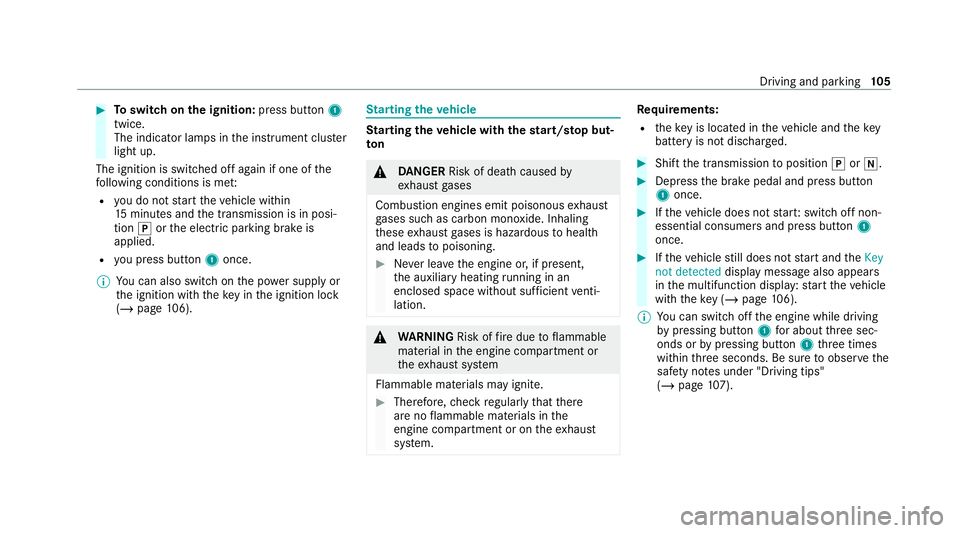
#
Toswitch on the ignition: press button 1
twice.
The indicator lamps in the instrument clus ter
light up.
The ignition is switched off again if one of the
fo llowing conditions is me t:
R you do not start theve hicle within
15 minutes and the transmission is in posi‐
tion jorthe electric parking brake is
applied.
R you press but ton1 once.
% You can also swit chon the po wer supp lyor
th e ignition with theke y in the ignition lock
(/ page 106). St
arting theve hicle St
arting theve hicle with thest art/s top but‐
ton &
DANG ER Risk of death caused by
ex haust gases
Combustion engines emit poisonous exhaust
ga ses such as carbon monoxide. Inhaling
th ese exhaust gases is hazardous tohealth
and leads topoisoning. #
Never lea vethe engine or, if present,
th e auxiliary heating running in an
enclosed space wi thout suf ficient venti‐
lation. &
WARNING Risk offire due toflammable
material in the engine compartment or
th eex haust sy stem
Flammable materials may ignite. #
Therefore, check regularly that there
are no flammable materials in the
engine compartment or on theex haust
sy stem. Re
quirements:
R theke y is located in theve hicle and thekey
battery is not dischar ged. #
Shift the transmission toposition jori. #
Depress the brake pedal and press button
1 once. #
Ifth eve hicle does not star t:switch off non-
essential consumers and press button 1
once. #
Ifth eve hicle still does not start and theKey
not detected display message also appears
in the multifunction display: start theve hicle
with theke y (/ page106).
% You can swit choff the engine while driving
by pressing button 1for about thre e sec‐
onds or bypressing button 1thre e times
within thre e seconds. Be sure toobser vethe
saf ety no tes under "Driving tips"
(/ page 107). Driving and parking
105
Page 204 of 441
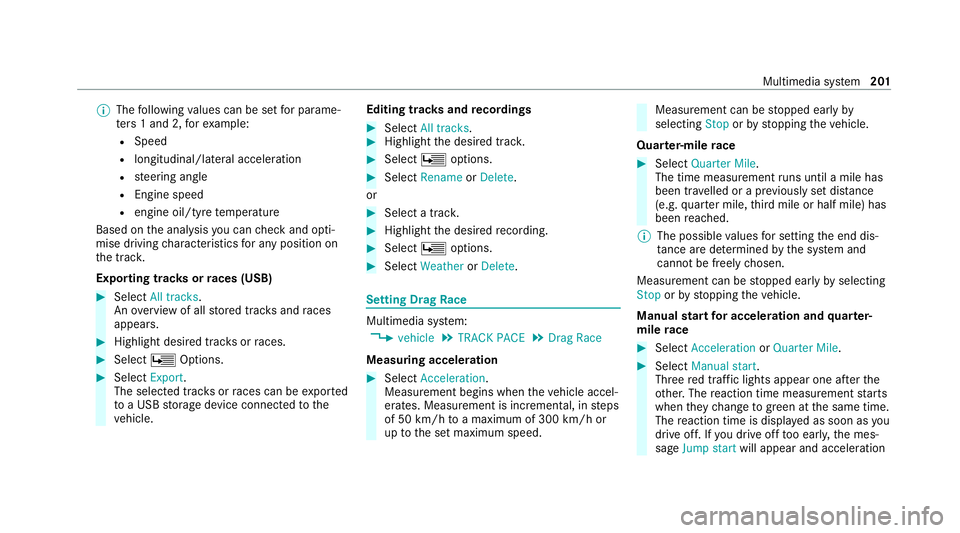
%
The following values can be set for parame‐
te rs 1 and 2, forex ample:
R Speed
R longitudinal/lateral acceleration
R steering angle
R Engine speed
R engine oil/tyre temp erature
Based on the anal ysis yo u can check and opti‐
mise driving characteristics for any position on
th e tra ck.
Exporting trac ksorraces (USB) #
Select All tracks.
An ove rview of all stored trac ksand races
appea rs. #
Highlight desired trac ksorraces. #
Select ÜOptions. #
Select Export.
The selected trac ksorraces can be expor ted
to a USB storage device connected tothe
ve hicle. Editing trac
ksand recordings #
Select All tracks. #
Highlight the desired trac k. #
Select Üoptions. #
Select Rename orDelete.
or #
Select a trac k. #
Highlight the desired recording. #
Select Üoptions. #
Select Weather orDelete. Setting Drag
Race Multimedia sy
stem:
4 vehicle 5
TRACK PACE 5
Drag Race
Measuring acceleration #
Select Acceleration.
Measurement begins when theve hicle accel‐
erates. Measurement is incremental, in steps
of 50 km/h toa maximum of 300 km/h or
up tothe set maximum speed. Measurement can be
stopped early by
selecting Stoporby stopping theve hicle.
Quar ter-mile race #
Select Quarter Mile.
The time measurement runs until a mile has
been tr avelled or a pr eviously set dis tance
(e.g. quarter mile, third mile or half mile) has
been reached.
% The possible values for setting the end dis‐
ta nce are de term ined bythe sy stem and
cann otbe freely chosen.
Measurement can be stopped early byselecting
Stop orby stopping theve hicle.
Manual start for accele ration and quarter-
mile race #
Select Acceleration orQuarter Mile . #
Select Manual start .
Three red traf fic lights appear one af terthe
ot her. The reaction time measurement starts
when they change togreen at the same time.
The reaction time is displa yed as soon as you
drive off. If you drive off too ear ly,th e mes‐
sage Jump start will appear and acceleration Multimedia sy
stem 201
Page 295 of 441
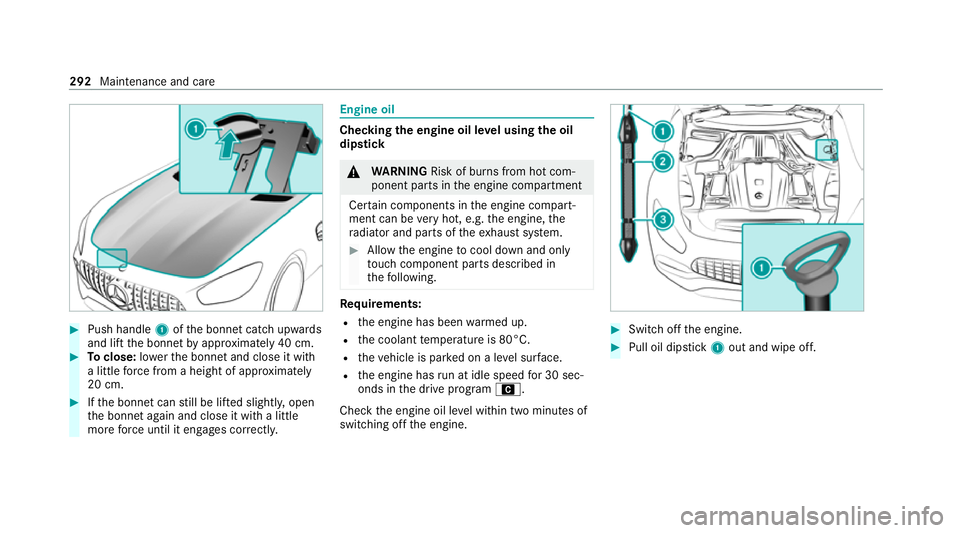
#
Push handle 1ofthe bonn etcatch up wards
and lift the bonn etby appr oximately 40 cm. #
Toclose: lowe rth e bonn etand close it with
a little forc e from a height of appr oximately
20 cm. #
Ifth e bonn etcan still be lif ted slightl y,open
th e bonn etagain and close it with a little
more forc e until it engages cor rectly. Engine oil
Che
cking the engine oil le vel using the oil
dip stick &
WARNING Risk of burn s from hot com‐
ponent parts in the engine compartment
Cer tain components in the engine compart‐
ment can be very hot, e.g. the engine, the
ra diator and parts of theex haust sy stem. #
Allow the engine tocool down and only
to uch co mponent parts described in
th efo llowing. Re
quirements:
R the engine has been warmed up.
R the coolant temp erature is 80°C.
R theve hicle is par ked on a le vel sur face.
R the engine has run at idle speed for 30 sec‐
onds in the drive program A.
Check the engine oil le vel within two minutes of
switching off the engine. #
Switch off the engine. #
Pull oil dipstick 1out and wipe off. 292
Maintenance and care
Page 315 of 441
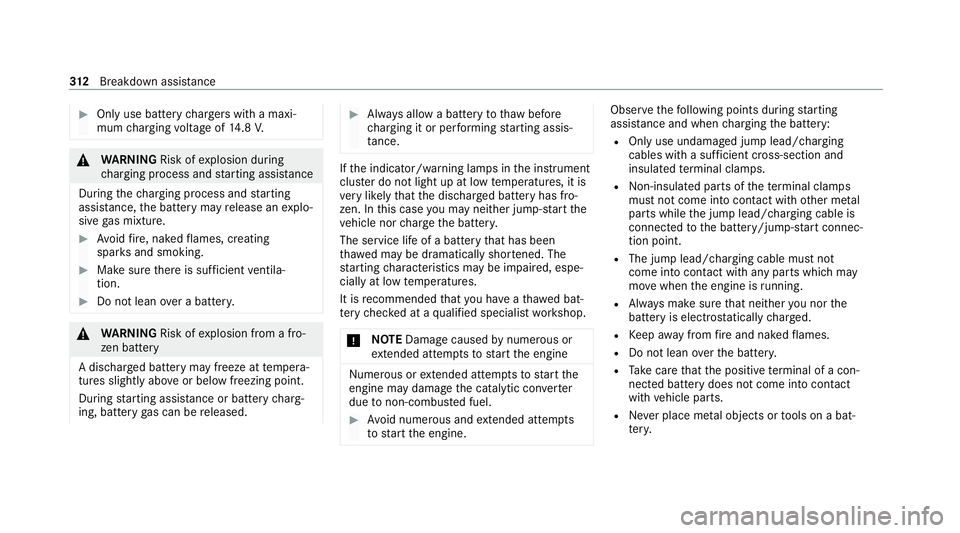
#
Only use battery charge rs with a maxi‐
mum charging voltage of 14.8 V. &
WARNING Risk ofexplosion during
ch arging process and starting assis tance
During thech arging process and starting
assis tance, the battery may release an explo‐
sive gas mixture. #
Avoid fire , naked flames, creating
spar ksand smoking. #
Make sure there is suf ficient ventila‐
tion. #
Do not lean over a batter y. &
WARNING Risk ofexplosion from a fro‐
zen battery
A dischar ged battery may freeze at temp era‐
tures slightly abo veor below freezing point.
During starting assis tance or battery charg‐
ing, bat tery gas can be released. #
Alw ays allow a battery tothaw before
ch arging it or per form ing starting assis‐
ta nce. If
th e indicator/warning lamps in the instrument
clus ter do not light up at low temp eratures, it is
ve ry likely that the dischar ged battery has fro‐
zen. In this case you may neither jump-s tart the
ve hicle nor charge the batter y.
The service life of a battery that has been
th awe d may be dramatically shor tened. The
st arting characteristics may be impaired, espe‐
cially at low temp eratures.
It is recommended that you ha veathaw ed bat‐
te ry checked at a qualified specialist workshop.
* NO
TEDama gecaused bynumerous or
ex tended attempt sto start the engine Nume
rous or extended attempt sto start the
engine may damage the catalytic con verter
due tonon-combu sted fuel. #
Avoid numerous and extended attem pts
to start the engine. Obser
vethefo llowing points during starting
assis tance and when charging the battery:
R Only use undamaged jump lead/charging
cables with a suf ficient cross-section and
insula tedte rm inal clamps.
R Non- insulated parts of thete rm inal clamps
must not come into con tact with other me tal
parts while the jump lead/charging cable is
connected tothe battery/jump-s tart connec‐
tion point.
R The jump lead/charging cable must not
come into contact wi thany parts which may
mo vewhen the engine is running.
R Alw ays make sure that nei ther you nor the
battery is elect rostatically charge d.
R Keep away from fire and naked flames.
R Do not lean overth e batter y.
R Take care that the positive term inal of a con‐
nec ted battery does not come into con tact
wi th vehicle parts.
R Never place me tal objects or tools on a bat‐
te ry. 312
Breakdown assis tance
Page 392 of 441
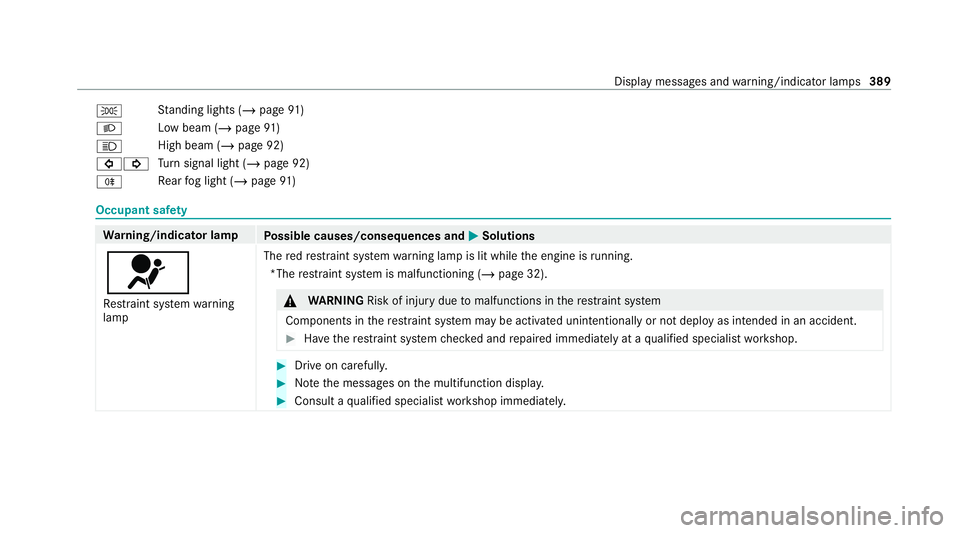
T
St
anding lights (/ page91 )
L Low beam (/
page91 )
K High beam (/
page 92)
#! Tu
rn signal light (/ page 92)
R Re
ar fog light (/ page91 ) Occupant saf
ety Wa
rning/indicator lamp
Possible causes/consequences and M MSolutions
6 Re stra int sy stem warning
lamp The
redre stra int sy stem warning lamp is lit while the engine is running.
*The restra int sy stem is malfunctioning (/ page 32). &
WARNING Risk of injury duetomalfunctions in there stra int sy stem
Components in there stra int sy stem may be activated unintentionally or not deploy as intended in an accident. #
Have there stra int sy stem checked and repaired immediately at a qualified specialist workshop. #
Drive on carefully. #
Notethe messages on the multifunction displa y. #
Consult a qualified specialist workshop immediatel y. Displ
aymessa ges and warning/indicator lamps 389
Page 398 of 441
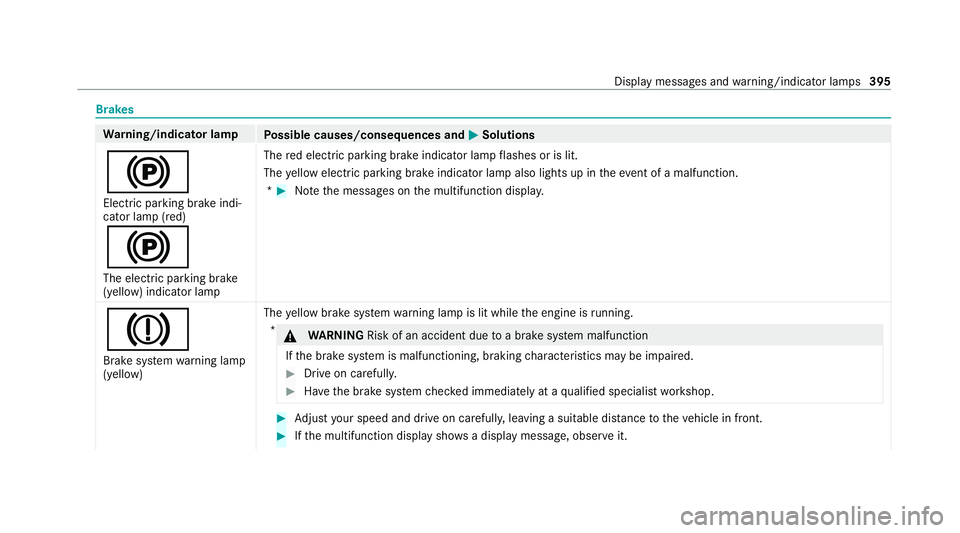
Brakes
Wa
rning/indicator lamp
Possible causes/consequences and M MSolutions
! Elect ric pa rking brake indi‐
cator lamp (red)
!
The elect ric pa rking brake
(yellow) indicator lamp The
red elect ric pa rking brake indicator lamp flashes or is lit.
The yellow elect ric pa rking brake indicator lamp also lights up in theev ent of a malfunction.
* #
Notethe messages on the multifunction displa y.
J
Brake sy stem warning lamp
(yellow) The
yellow brake sy stem warning lamp is lit while the engine is running.
* &
WARNING Risk of an accident due toa brake sy stem malfunction
If th e brake sy stem is malfunctioning, braking characteristics may be impaired. #
Drive on carefull y. #
Have the brake sy stem checked immediately at a qualified specialist workshop. #
Adjust your speed and drive on carefull y,leaving a suitable dis tance totheve hicle in front. #
Ifth e multifunction display sho wsa display message, obse rve it. Display messages and
warning/indicator lamps 395
Page 414 of 441
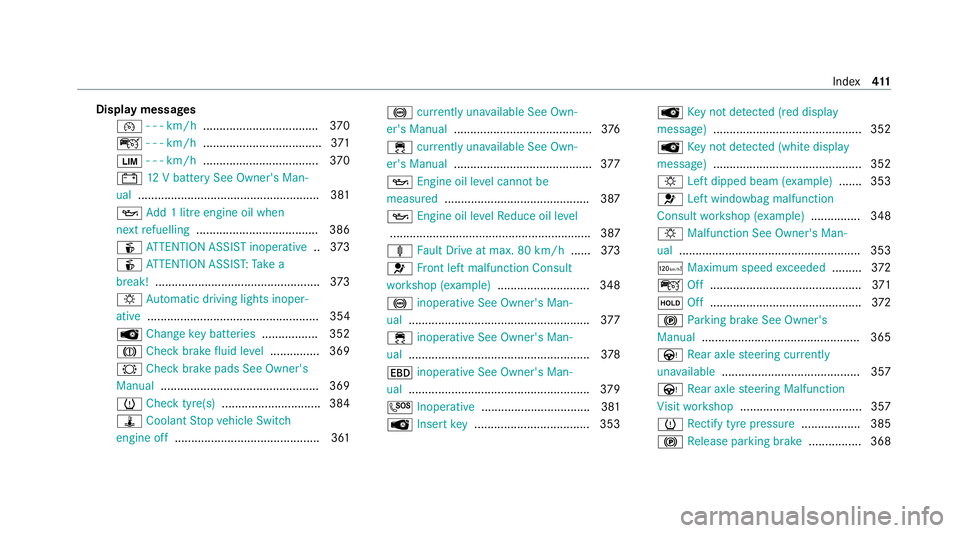
Display messages
¯ - - - km/h .................................. .370
ç - - - km/h ................................... .371
È - - - km/h ................................... 370
# 12V battery See Owner's Man‐
ual ....................................................... 381
5 Add 1 litre engine oil when
next refuelling .................................... .386
é ATTENTION ASSIST inoperative ..373
é ATTENTION ASSIS T:Take a
break! .................................................. 373
: Automatic driving lights inoper‐
ative .................................................... 354
 Change key bat teries ................. 352
J Check brake fluid le vel.............. .369
# Checkbrake pads See Owner's
Manual ................................................ 369
h Check tyre(s) .............................. 384
ÿ Coolant Stop vehicle Switch
engine off ............................................ 361 !
currently una vailable See Own‐
er's Manual .......................................... 376
÷ currently una vailable See Own‐
er's Manual .......................................... 377
5 Engine oil le vel cannot be
measured ............................................ 387
5 Engine oil le velRe duce oil le vel
............................................................. 387
ä Fault Drive at max. 80 km/h ......373
6 Front left malfunction Consult
wo rkshop (e xample)............................ 348
! inoperative See Owner's Man‐
ual ....................................................... 377
÷ inoperative See Owner's Man‐
ual ....................................................... 378
T inoperative See Owner's Man‐
ual ....................................................... 379
G Inoperative .................................3 81
 Insert key .................................. .353 Â
Key not de tected (red displ ay
messa ge).............................................3 52
 Key not de tected (white display
messa ge).............................................3 52
: Left dipped beam (e xamp le) .......3 53
6 Left wind owbag malfunction
Consult workshop (e xample).............. .348
: Malfunction See Owner's Man‐
ual ....................................................... 353
ð Maximum speed exceeded ......... 372
ç Off..............................................3 71
ë Off..............................................3 72
! Parking brake See Owner's
Manual ................................................ 365
Ù Rear axle steering cur rently
una vailable .......................................... 357
Ù Rear axle steering Malfunction
Vi sit workshop .....................................3 57
h Rectify tyre pressure .................. 385
! Release parking brake ................ 368 Index
411